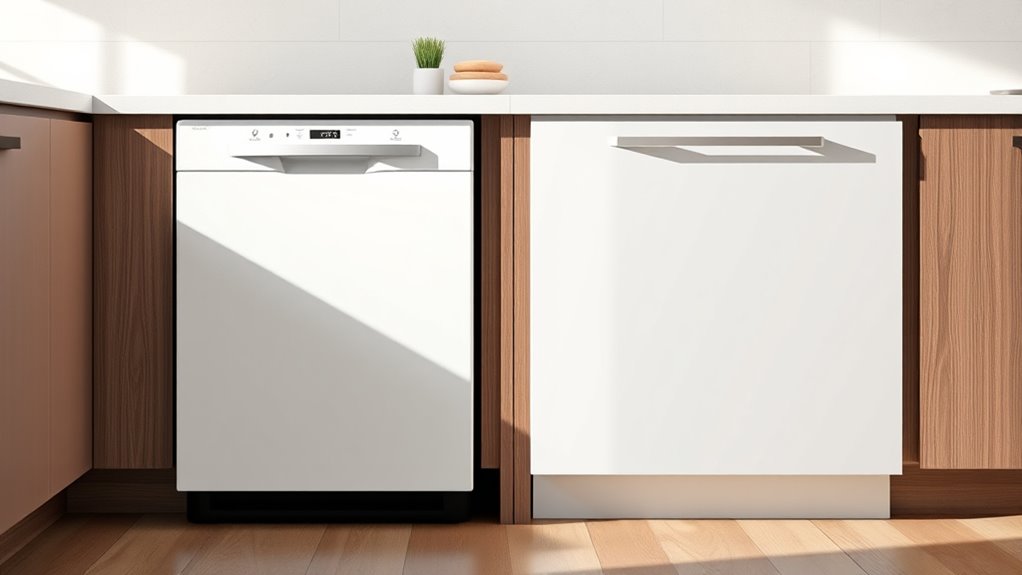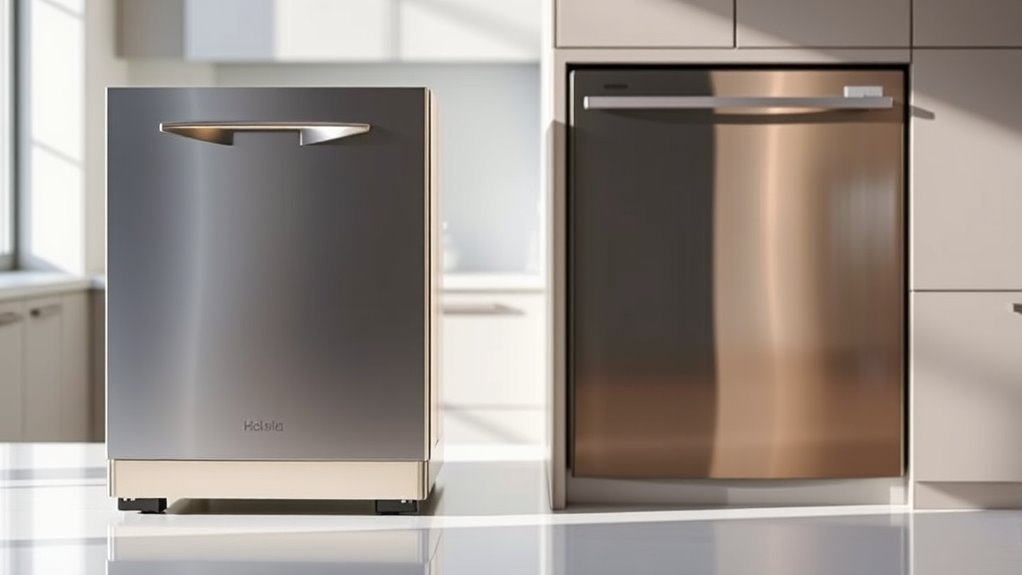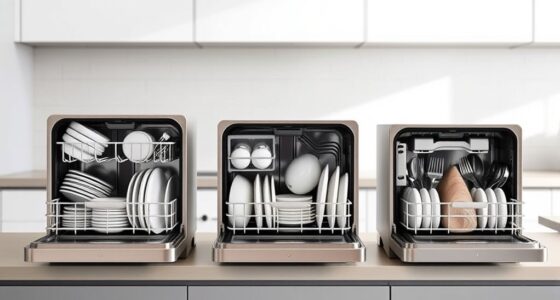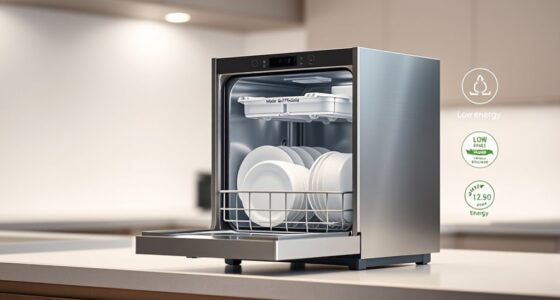If you’re choosing between compact dishwashers and built-in models, consider your space, needs, and style. Compact units are portable, easy to install, and perfect for small kitchens or renters, but they often have less capacity and fewer features. Built-in models are larger, integrated, and more efficient for busy households, but they require professional installation and custom cabinetry. To find out which option best fits your lifestyle, explore the detailed pros and cons below.
Key Takeaways
- Compact dishwashers are portable, easier to install, and ideal for small spaces or renters, while built-in models are permanent and integrate seamlessly into kitchens.
- Built-in dishwashers generally have larger capacities and advanced energy-saving features compared to compact units.
- Compact models use less water and electricity per cycle, making them more efficient for small households, but may require multiple cycles for larger loads.
- Built-in dishwashers require professional installation and customization, whereas compact units are simple to set up and move.
- The design choice depends on whether you prioritize flexibility and portability or a sleek, integrated kitchen appearance.

When choosing a dishwasher, you’ll often find two main options: compact dishwashers and built-in models. Each has its distinct advantages and drawbacks, especially when it comes to energy efficiency and installation complexity. Compact dishwashers are typically smaller, designed to fit into tight spaces like apartment kitchens or small laundry rooms. They tend to use less water and electricity per cycle, making them an energy-efficient choice for smaller households or those looking to save on utility bills. However, their smaller size can mean fewer features and less capacity, which might require you to run more cycles if you have a lot of dishes to wash. They’re also generally easier to use and move, making them suitable for renters or anyone who values flexibility. Additionally, compact dishwashers often feature simpler controls and are more adaptable to different living situations.
Built-in models, on the other hand, are permanently installed under your kitchen counter, blending seamlessly with your cabinetry. They usually offer larger capacities and more advanced features, which can be a big plus if you have a busy household or entertain often. When it comes to energy efficiency, built-in dishwashers are often more efficient than their portable counterparts, thanks to newer models that incorporate advanced energy-saving technologies. However, their installation can be more complex. You might need to hire a professional to properly connect water, drain, and electrical lines, which adds to the initial cost and effort. Once installed, they tend to be more permanent, giving your kitchen a sleek, integrated look that can boost your home’s overall aesthetic.
If you’re concerned about installation complexity, compact dishwashers win because they usually only require a standard electrical outlet and a water hookup, which can often be done without much hassle. They’re also more portable, so if you move, you can take them with you. Built-in models demand a more involved setup, often requiring custom cabinetry or modifications, which can be costly and time-consuming. But in return, they usually provide a more built-in look and larger capacity, ideal for those who want a seamless kitchen design and don’t plan to move frequently.
Frequently Asked Questions
Can Compact Dishwashers Handle Large Families’ Dish Loads?
Compact dishwashers typically can’t handle large family-sized dish loads efficiently. If you have a big family, you might find their dish load capacity limiting, as they usually accommodate fewer dishes at once. You’ll likely need to run multiple cycles, which can be inconvenient and time-consuming. For large families, built-in models with higher dish load capacity are a better choice, making cleaning quicker and more efficient.
Are Built-In Dishwashers More Energy-Efficient Than Portable Models?
Built-in dishwashers are generally more energy-efficient than portable models because they often have advanced features that promote energy savings, like better insulation and targeted wash cycles. This not only reduces your utility bills but also minimizes environmental impact. You’ll notice a difference in performance and sustainability, making built-in options a smart choice if you’re aiming to lower your carbon footprint while keeping your dishes clean efficiently.
How Long Does Installation Typically Take for Each Type?
You might think installation always takes forever, but it actually varies. Compact dishwashers typically need just a few hours because their setup is simple and straightforward. Built-in models, however, involve more setup complexity, so they usually take a day or two. Your installation timeline depends on your home’s plumbing and electrical setup, but overall, compact models are quicker and easier to install than built-in ones.
Do Compact Dishwashers Require Special Plumbing Connections?
No, compact dishwashers usually don’t require special plumbing connections. They typically connect to standard water supplies and drain hoses, making their installation less complex. You might need to check your plumbing requirements to verify compatibility, but overall, the installation complexity is lower compared to built-in models. Most homeowners find that connecting a compact dishwasher is straightforward and can often be done without professional help.
Can Built-In Dishwashers Be Easily Moved or Replaced?
Ever wonder if you can easily move or replace your built-in dishwasher? While they’re designed to be fixed in place, replacing or relocating one isn’t impossible but can be challenging due to removal difficulty and plumbing connections. You’ll need to disconnect water, electrical, and drainage lines carefully. If you’re planning a renovation or want flexibility, consider how easily your built-in model can be replaced or moved before installation.
Conclusion
Choosing between compact dishwashers and built-in models depends on your space and lifestyle. While compact units offer portability and convenience, built-in models provide seamless integration and often larger capacity. Each has its strengths and limitations, so consider what matters most—whether flexibility or permanence. Ultimately, your choice balances practicality with aesthetics, reminding you that sometimes, the most adaptable option isn’t always the most integrated; both serve different needs, shaping your kitchen’s functionality and style.









